Adige
The Adige (Italian: [ˈaːdidʒe]; German: Etsch [ɛtʃ] (![]()
![]()
| Adige | |
|---|---|
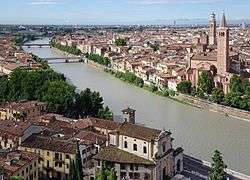 The Adige in Verona | |
 Map of the Adige River | |
| Etymology | Latin Athesis, from Celtic *yt-ese, "the water" |
| Native name | Etsch (German) Adige (Italian) Àdexe (Venetian) Adisch (Romansh) Adesc (Ladin) |
| Location | |
| Country | Italy |
| Physical characteristics | |
| Source | Reschen Pass |
| • location | Graun im Vinschgau, South Tyrol, Italy |
| • coordinates | 46°50′04″N 10°30′53″E |
| • elevation | 1,520 m (4,990 ft) |
| Mouth | Adriatic Sea |
• location | Italy |
• coordinates | 45°8′59″N 12°19′13″E |
| Length | 410 km (250 mi) |
| Basin size | 12,100 km2 (4,700 sq mi) |
| Discharge | |
| • average | 235 m3/s (8,300 cu ft/s) |
The river's name is Celtic in origin, from the Proto-Celtic *yt-ese, "the water", cognate with the River Tees in England (anciently Athesis, Teesa).[2]
Description
The river source is near the Reschen Pass (1,504 metres (4,934 ft)) close to the borders with Austria and Switzerland above the Inn valley. It flows through the artificial alpine Lake Reschen. The lake is known for the church tower that marks the site of the former village of Alt Graun ("Old Graun"); it was evacuated and flooded in 1953 after the dam was finished. Near Glurns, the Rom river joins from the Swiss Val Müstair.
The Adige runs eastward through the Vinschgau to Merano, where it is met by the Passer river from the north. The section between Merano and Bolzano is called Etschtal, meaning Adige Valley. South of Bolzano, the river is joined by the Eisack and turns south through a valley which has always been one of the major routes through the Alps, connecting the Reschen and the Brenner passes, at 1,370 metres (4,490 ft) considered the easiest of the main Alpine passes.
The Chiusa di Salorno narrows at Salorno mark the southernmost part of the predominantly German-speaking province of South Tyrol. The Adige was mentioned in the "Lied der Deutschen" of 1841 as the southern border of the German language area. As of 2011 62% of Salorno speaks Italian and 37% speaks German.[3] In 1922 Germany adopted the song as its national anthem, although by that time Italy had taken control of all of the Adige.
Near Trento, the Avisio, Noce, and Fersina rivers join. The Adige crosses Trentino and later Veneto, flowing past the town of Rovereto, the Lagarina Valley, the cities of Verona and Adria and the north-eastern part of the Po Plain into the Adriatic Sea. The Adige and the Po run parallel in the river delta without properly joining.
The Adige is connected to Lake Garda by the Mori-Torbole tunnel, an artificial underground canal built for flood prevention.
Tributaries
The following rivers are tributaries to the river Adige (from source to mouth):
- Left: Karlinbach, Punibach, Schnalser Bach, Passer, Eisack, Avisio
- Right: Rom, Suldenbach, Plima, Falschauer
Ecology
Fauna

The Adige is a home to the marble trout (Salmo marmoratus), but at far lower populations than in the past. Fish stocking is one of the most significant causes of the sharp reduction in the original (indigenous) fish population of this subspecies. It will spawn with and interbreed with brown trout, which are regularly stocked in the river and its tributaries.[4]
Gallery
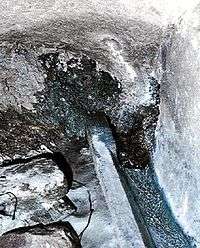 The true source of Adige inside a bunker of the Alpine Wall
The true source of Adige inside a bunker of the Alpine Wall- The false source
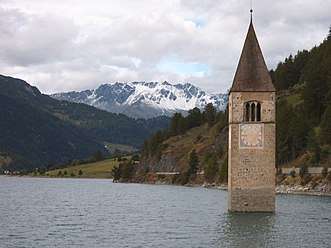
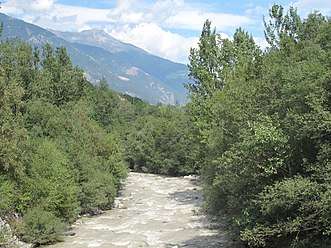 The Adige between Laas and Göflan in the Vinschgau.
The Adige between Laas and Göflan in the Vinschgau.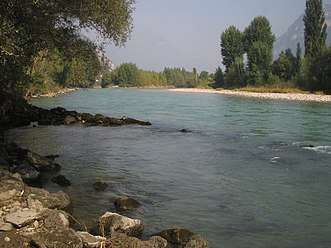 The Adige flowing through Lagarina Valley.
The Adige flowing through Lagarina Valley.- The Adige flowing through Verona.
 The Adige flowing through Verona, as seen from the Castelvecchio Bridge.
The Adige flowing through Verona, as seen from the Castelvecchio Bridge. The Adige flowing through Verona.
The Adige flowing through Verona.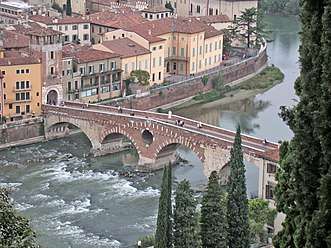 The Adige flowing through Verona seen from Castel San Pietro.
The Adige flowing through Verona seen from Castel San Pietro.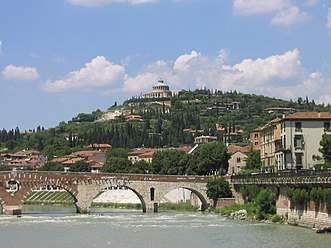 Adige river and Ponte Pietra in Verona.
Adige river and Ponte Pietra in Verona.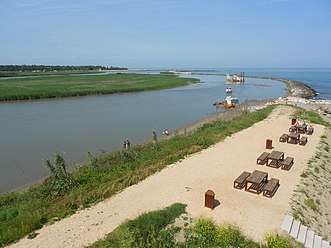 The mouth of the Adige at Rosolina Mare
The mouth of the Adige at Rosolina Mare
See also
- Leno, one of the main tributaries of the Adige river
References
- "Athesis, Athesis". Numen - The Latin Lexicon - An Online Latin Dictionary - A Dictionary of the Latin Language.
- Local Etymology: A Derivative Dictionary of Geographical Names. Houlston and Wright. 22 May 2019 – via Google Books.
- "Linguistic census province of Bolzano 2011" (PDF). 2011.
- Karel Kovar "Hydrology, Water Resources and Ecology in Headwaters". p. 505